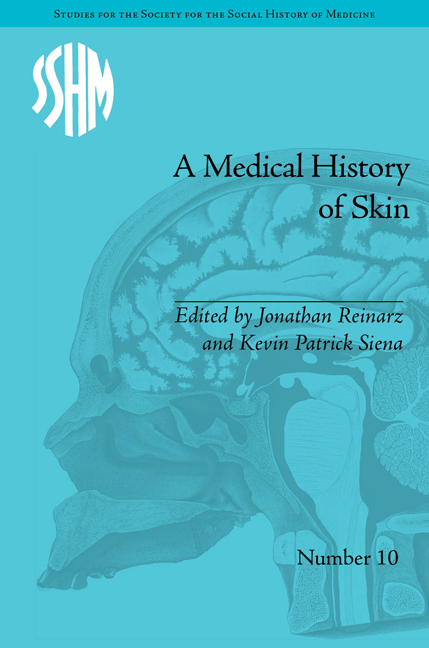Book contents
- Frontmatter
- CONTENTS
- List of Contributors
- List of Figures and Tables
- Scratching the Surface: An Introduction
- Part I The Emerging Skin Field
- Part II Skin, Stigma and Identity
- 5 The Moral Biology of ‘the Itch’ in Eighteenth-Century Britain
- 6 Syphilis, Backwardness and Indigenous Skin Lesions through French Physicians' Eyes in the Colonial Maghreb, 1830–1930
- 7 Discovering the ‘Leper’: Shifting Attitudes towards Leprosy in Twentieth-Century Uganda
- 8 Sex and Skin Cancer: Kaposi's Sarcoma Becomes the ‘Stigmata of AIDS’, 1979–83
- Part III Skin, Disease and Visual Culture
- Afterword: Reading the Skin, Discerning the Landscape: A Geo-historical Perspective of our Human Surface
- Notes
- Index
5 - The Moral Biology of ‘the Itch’ in Eighteenth-Century Britain
from Part II - Skin, Stigma and Identity
- Frontmatter
- CONTENTS
- List of Contributors
- List of Figures and Tables
- Scratching the Surface: An Introduction
- Part I The Emerging Skin Field
- Part II Skin, Stigma and Identity
- 5 The Moral Biology of ‘the Itch’ in Eighteenth-Century Britain
- 6 Syphilis, Backwardness and Indigenous Skin Lesions through French Physicians' Eyes in the Colonial Maghreb, 1830–1930
- 7 Discovering the ‘Leper’: Shifting Attitudes towards Leprosy in Twentieth-Century Uganda
- 8 Sex and Skin Cancer: Kaposi's Sarcoma Becomes the ‘Stigmata of AIDS’, 1979–83
- Part III Skin, Disease and Visual Culture
- Afterword: Reading the Skin, Discerning the Landscape: A Geo-historical Perspective of our Human Surface
- Notes
- Index
Summary
Historians of eighteenth-century institutions, whether jails, workhouses, orphanages or hospitals, are familiar with a disease vaguely termed ‘the itch’. Infirmary reports for the workhouse in St Margaret's Westminster identify it as the second most common ailment, while prison records occasionally went further; in 1782 three-quarters of the female patients in Clerkenwell Bridewell's infirmary had it. Hospitals typically refused sufferers for fear of epidemics in the wards. The itch was omnipresent, nagging, disfiguring and heavily moralized, yet few scholars have analysed it.
Debate about what caused the itch colours both its history and historiography. Indeed, the records suggest significant diagnostic confusion. Doctors trying to make sense of it often linked it to diseases like leprosy and the pox, with two important results. Firstly, this enhanced the range of terms and ideas associated with the disease and complicated its interpretation. Secondly, this magnified the opinion that the itch was odious. Since at least the time of medieval leprosy, unsightly skin infections were read to evidence moral failure, a belief still robust in eighteenth-century Britain. The itch thus became a multi-barbed rhetorical weapon put to a range of nasty uses. Moreover, doctors lent credence to some of the period's distasteful prejudices. Although they debated much, physicians discussing the itch agreed that identifiable elements of British society generated it, suggesting physiological distinctions for classes and nations.
To historians of dermatology, the itch was scabies, the infection caused by the parasite Sarcoptes scabiei. Medical dictionaries show that the term ‘scabies’ was used during the Enlightenment: ‘Scabies, a scab, is used sometimes for the itch, and such like cutaneous eruptions’.
- Type
- Chapter
- Information
- A Medical History of SkinScratching the Surface, pp. 71 - 84Publisher: Pickering & ChattoFirst published in: 2014

